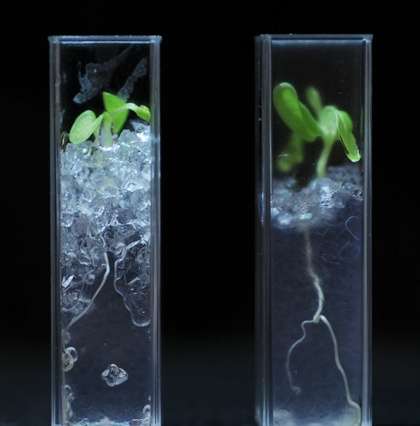Transparent soil allows detailed study of roots

(Phys.org)—A team of researchers from the James Hutton Institute and the University of Abertay Dundee have developed a see-through soil which will enable them to study roots in detail for the first time.
Addressing global issues such as food security, disease transmission and climate change presents researchers with a variety of challenges, including the study of the underground world of plant roots; called the rhizosphere. The creation of the new see-through soil marks a milestone in the study of the rhizosphere and will have applications in many different areas of research.
Lionel Dupuy, a theoretical biologist in the Ecological Sciences group at the James Hutton Institute, said: "With this new technique, scientists now have a way to observe soil processes, live and in situ. This is exciting because there are so many things to discover in soil and we don't know yet what they are."
After two years of painstaking research to find a compound that could replicate soil chemistry, the team found success with a synthetic composite known as Nafion, often used in power-generating fuel cells.
This artificial soil is not especially transparent on its own: it becomes translucent when saturated with a special water-based solution. The product is a substrate which is very similar to real soil in terms of physical and biological variables, such as water retention, ability to hold nutrients and capability for sustaining plant growth.
Dr Dupuy explained: "There are many different scientific disciplines that could benefit from this research. Transparent soils could be used to study the spread and transmission of soil borne pathogens.
"In crop genetics, transparent soils could be used to screen the root systems of a range of genotypes. This would help breed crops with more efficient root systems so that agriculture can rely less on fertilisers.
"Physiologists could also use transparent soils to understand how plants or microbes access nutrients that are heterogeneously distributed in soil. Soil ecologists could use this system to make microcosm experiments where observation on interactions of different species can be observed," he added.
According to the team behind the see-through soil, future paths of research will focus on controlling a greater range of chemical and physical properties, so that applications of transparent soils to the many disciplines of soil biology are possible. They also hope to lower the overall cost of the technique, so that it can be used by everyone and at a larger scale.
More information: Transparent Soil for Imaging the Rhizosphere. 2012. Downie, H., Holden, N., Otten, W., Spiers, A.J., Valentine, T.A., Dupuy, L.X. PLoS ONE 7(9): e44276. (doi:10.1371/journal.pone.0044276) www.plosone.org/article/info%3Adoi%2F10.1371%2Fjournal.pone.0044276
Journal information: PLoS ONE
Provided by University of Abertay Dundee















